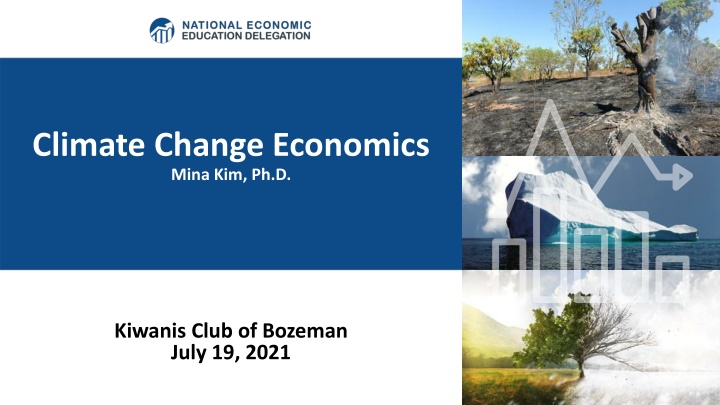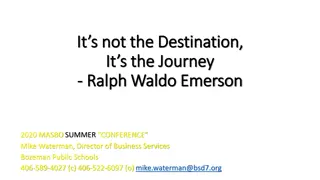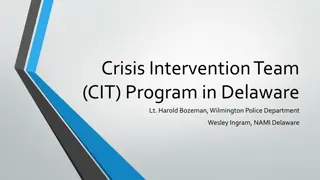
Climate Change Economists
Learn how economists contribute to climate change discussions by assessing behavioral reactions, estimating economic costs, and designing policies to balance economic growth with emission mitigation. Discover the concept of pollution as an externality and the need for a balance between pollution and human benefits in society.
Uploaded on | 0 Views
Download Presentation

Please find below an Image/Link to download the presentation.
The content on the website is provided AS IS for your information and personal use only. It may not be sold, licensed, or shared on other websites without obtaining consent from the author. If you encounter any issues during the download, it is possible that the publisher has removed the file from their server.
You are allowed to download the files provided on this website for personal or commercial use, subject to the condition that they are used lawfully. All files are the property of their respective owners.
The content on the website is provided AS IS for your information and personal use only. It may not be sold, licensed, or shared on other websites without obtaining consent from the author.
E N D
Presentation Transcript
Climate Change Economics Mina Kim, Ph.D. Kiwanis Club of Bozeman July 19, 2021
National Economic Education Delegation Vision - One day, the public discussion of policy issues will be grounded in an accurate perception of the underlying economic principles and data. Mission - NEED unites the skills and knowledge of a vast network of professional economists to promote understanding of the economics of policy issues in the United States. NEED Presentations - Are nonpartisan and intended to reflect the consensus of the economics profession. 2
Who Are We? Honorary Board: 47 members - 2 Fed Chairs: Janet Yellen, Ben Bernanke - 6 Chairs Council of Economic Advisers o Furman (D), Rosen (R), Bernanke (R), Yellen (D), Tyson (D), Goolsbee (D) - 3 Nobel Prize Winners o Akerlof, Smith, Maskin Delegates: 500+ members - At all levels of academia and some in government service - All have a Ph.D. in economics - Crowdsource slide decks - Give presentations Global Partners: 45 Ph.D. Economists - Aid in slide deck development 3
Credits and Disclaimer This slide deck was authored by: - Shana Mcdermott, Trinity University - Sarah Jacobson, Williams College - Sharon Shewmake, Western Washington University This slide deck was reviewed by: - Jason Shogren, University of Wyoming - Walter Thurman, North Carolina State University Disclaimer - NEED presentations are designed to be nonpartisan. - It is, however, inevitable that the presenter will be asked for and will provide their own views. - Such views are those of the presenter and not necessarily those of the National Economic Education Delegation (NEED). 4
How Can Economists Contribute to Thinking about Climate Change? By assessing behavioral reactions to climate change. By measuring the damage and estimating the economic costs of fighting climate change. By designing smart policies that minimize costs. - Balance economic growth with GHG emission mitigation. 5
Pollution is an externality Human activity creates pollution. - The goal is not zero pollution but society s best balance between pollution and human benefits. Pollution is an EXTERNALITY: a side effect (cost or benefit) that affects someone else when something is bought or sold - The power company sells you electricity for your house, but the pollution from the power plant affects everyone, not just you. - This is a market failure. All of the effects are not always felt by the buyers and sellers. - The price of electricity does not reflect all of the costs, leading to too much pollution - Electricity is too cheap. The balance is wrong.
Social Cost of Carbon Cost above price paid. The expected cost of damages from each unit of greenhouse gas emissions. Current EPA estimate: ~$40 per metric ton of CO2. - About $123/car per year. - $26 Billion for all vehicles in the US. Social cost of carbon will increase over time.
Economics of Responding to Climate Change
Cost-Benefit Analysis of Fighting Climate Change Most economic models suggest the costs of keeping warming below 2 C are relatively small. - Costs amount to 1-4% of GDP by 2030. Costs of acting to keep warming below 2 C are almost certainly less than future economic damages they would avoid. - Damages estimated to be between: 7 - 20% of worldwide GDP. Caveats: - Putting a monetary value on priceless things - Inequality - Uncertainty and risk
Present Value of a Future $100 Cost or Benefit It is better to be roughly right than precisely wrong. - John Maynard Keynes
Economic Growth and Climate Change Action Are Compatible Abating greenhouse gas emissions is costly but climate change damages are even more costly. Economic growth comes with consequences that we have to deal with, including climate consequences. Economies with environmental regulations can still be dynamic. Goal: design policies that reach climate goals at the least possible cost.
Policies That Reduce Emissions: Directly Regulation - Emissions standards or limits o E.g., CAFE standards Market-oriented policies - Putting a price on emissions o Subsidizing green energy (e.g., feed-in tariffs) o Tax or cap & trade 13
How Does Cap and Trade Work? Activities to be covered are determined. Acceptable emissions levels are indicated. Permits that allow acceptable emissions levels are issued. - How? o According to historical emissions? o Evenly across emitters? o Sold at some price? A market is developed. Those desiring to emit will have to buy sufficient permits to accommodate their emissions. Those wishing to abate will offer their permits on the market . - The price of a permit indicates: o The benefit of eliminating further emissions. o The cost of emitting. Gov t agency determines equality of permits in possession and emissions. 14
How Does a Carbon Tax Work? Activities to be covered are determined. The price of emissions is determined. - Presumably some relation to the social cost of polluting. Emissions are measured. Taxes are determined. Q: What to do with the tax revenue? 15
Carbon Prices: the Good and Bad Good: - Provide price signal to lower emissions. - They yield low-cost reductions in emissions. - They spur innovation in clean technologies. Bad: - Firms might leave to flee regulation. - It is necessary to monitor emissions. - Potentially regressive o Costs may weigh more heavily on low- income households.
Revenue Dividend Eliminates Regressivity 17 Source: U.S. Treasury, 2017
Carbon Tax and Cap & Trade: the Differences Carbon Tax Cap & Trade Carbon Price Certain Uncertain Emissions Uncertain Certain Ease of Implementation May be easier to implement Additional concerns Always generates revenue May require legislation to change May be more susceptible to lobbying Only generates revenue if government sells permits Cap can be changed by regulator
Carbon Tax and Cap & Trade: the Differences Carbon Tax Cap & Trade Carbon Price Certain Uncertain Emissions Uncertain Certain Ease of Implementation May be easier to implement Additional concerns 1) Always generates revenue 2) May require legislation to change 3) Predictability 1) Susceptible to lobbying. 2) Only generates revenue if government sells permits. 3) Cap can be changed by regulator. 4) Less certainty over future. 5) Regulations reduce efficacy of Cap & Trade
One Other Thing: Cap and Trade vs. Carbon Tax Emissions regulations and Cap and Trade can work at cross purposes. - Regulations that lower emissions from big polluters o Lower the demand for permits o Lowers the price of permits o Reduces incentives for other industries to cut emissions Regulations can undermine the effectiveness of Cap and Trade. The same is not true of a carbon tax. - Though regulations might cut tax revenue, revenue is not the goal of the carbon tax. 20
Thoughts on Regulation vs Market-Oriented Equity. - Both types of policies are regressive. o Cap and Trade and a Carbon Tax can offset the regressivity. o Regulations do not. Efficiency. - Market-oriented policies tend to achieve emissions reduction at much lower cost. o Example: CAF Standards vs Carbon Tax Tax is significantly more efficient. Why? 21
Efficiency: CAF vs Carbon Tax CAF = Corporate Average Fuel Efficiency - A fuel economy standard mandating that an auto maker s vehicle fleet must meet minimum fuel economy standards. Horse Race - Tax on fuel applies to ALL vehicles, not just new. - Rebound Effect: o Driving a more efficient vehicle lowers the cost per mile driven leading to more miles driven. - Slower turnover of inefficient vehicles: higher cost of new. Summary - A given level of emission reductions costs 3-14 times more with CAF standards than under a comparable carbon tax. 22
Policies That Reduce Emissions: INDirectly Subsidizing R&D Grid / infrastructure Energy efficiency mandates and subsidies Mandating renewable energy (e.g., renewable portfolio standards) Land use policies
Challenges with Renewable Energy It s intermittent - only produced if there is sun or wind. Energy is needed all day and night, with peak times. Limited w/o storage. - Creative storage options are under development.
Infrastructure and Climate Change $90 trillion in investment will be needed for U.S. infrastructure, 2015-2030. Add $4 trillion (< 5%) to make it low-carbon infrastructure. - This would also reduce climate damage to infrastructure. - Railway, urban transport, renewables. The electrical grid is particularly troublesome. - It is outdated and not suited for renewable energy storage. - Those with solar panels use the grid but contribute little to its upkeep.
Bidens Climate Plan Regulation and infrastructure investment aimed at meeting specific climate targets and creating jobs He also pressed the need to link environmental advocacy to racial justice, describing pollution and other toxic harms that disproportionately affect communities of color. His plan calls for establishing an office of environmental and climate justice at the Justice Department and developing a broad set of tools to address how environmental policy decisions of the past have failed communities of color. - Mr. Biden set a goal for disadvantaged communities to receive 40 percent of all clean energy and infrastructure benefits he was proposing. He also made explicit references to tribal communities and called for expanding broadband access to tribal lands. Plan will be paid for using corporate income taxes. 26
Economic policies will be central to accomplishing the goals we choose. - Harris and Roach (2007)
Summary Climate change is real, is caused by human actions, and has impacts we re already feeling. We need to reduce emissions to balance the costs of action against the costs of inaction. Scientists and the IPCC recommend that we work to keep warming below 1.5 degrees celcius. - Economists believe that this goal is well worth the costs!
Summary continued There are many ways to reduce emissions. Economics-inspired policies can help us do this at the lowest cost. Taxes and cap and trade are proven effective tools to fight climate change! Other tools may also be necessary.
Thank you! Any Questions? www.NEEDelegation.org Mina Kim minakim@mkecon.com Contact NEED: Info@NEEDelegation.org Submit a testimonial: www.NEEDelegation.org/testimonials.php 30


















